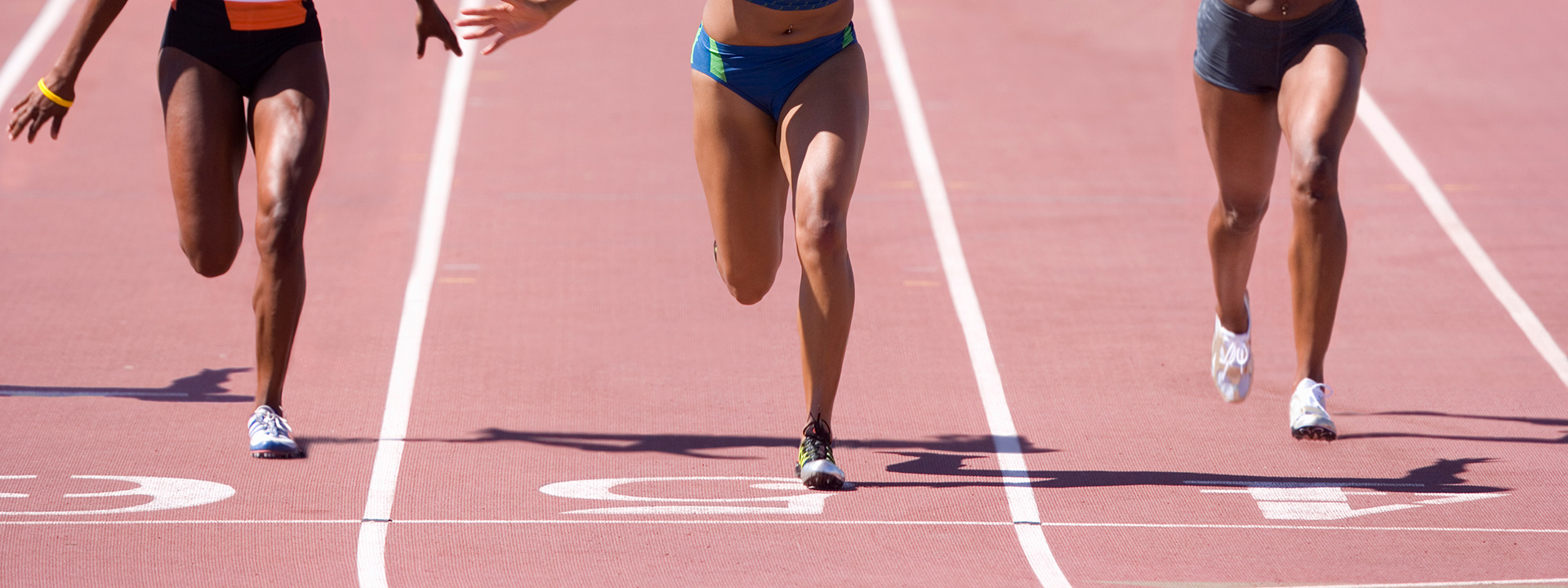
Testing Running Biomechanics with Plantar Pressure Mapping
Endurance-based sports are characterized by a biomechanical continuum between force application and movement efficiency. Distance runners need to focus heavily on movement efficiency while also developing the ability to switch to sprinting-oriented mechanics in the final meters of a race.
The biomechanical requirements of a mid or long distance runner are different from those of a short distance sprinter as it depends where they fall in the force application-movement efficiency continuum (see Figure 1 below).
Figure 1. The Force Application - Movement Efficiency Continuum
Force Application and Movement Efficiency
Where an activity falls in the continuum largely depends on the primary goal of the discipline. Short distance sprinting relies more on force application due to the need to produce higher levels of power to propel the mass of the body forward at very short ground contact times. Mid and long distance running relies on the efficiency of movement in order for the body to optimize the delicate balance between force production and shock absorption.
Running for long distances involves thousands of impacts on the ground to happen, generating cumulative stresses on muscles, tendons, and joints that need to be counterbalanced by running mechanics geared towards proper movement efficiency.
What Is Running Efficiency?
There are three components of efficiency in running that contribute to the definition of Running Economy, which is the metric used in research to classify the overall efficiency in runners.
The three components are:
- Biomechanical efficiency, related to the mechanical pattern of movement and its implications towards running;
- Neural efficiency, related to the ability of the central nervous system to properly recruit and activate muscles;
- Metabolic efficiency, related to the metabolic factors associated with energy production, such as oxygen delivery and fuel sources.
For the scope of this article we focus on biomechanical efficiency and how to evaluate a distance runner’s biomechanics using plantar pressure measurement technology, like XSENSOR’s Intelligent Insoles.
What to Look For in a Distance Runner?
As previously mentioned, a distance runner has a different biomechanical approach with respect to short distance sprinters, both in kinematic and kinetic factors (Williams & Cavanagh, 1987).
Kinematic factors including stride length, have shown to be highly correlated with running economy (Moore, 2016), whereas kinetic factors include impact peak and vertical impulses (Heise & Martin, 2001).
Biomechanical efficiency in running has to do with passive mechanics in the context of how the human body creates movement. Passive mechanics relates to movement efficiency, including elastic energy storage, stride mechanics, and foot strike (Magness, 2014).
The ability to properly use the storage-release mechanism of elastic energy is one of the most important factors in efficient running mechanics. It depends on how a person prepares for the impact with the ground, directly affecting the ability of the Achilles-calf complex to efficiently use the elastic energy.
The dynamics of the foot strike is also important as it is correlated with the elastic energy storage mechanism. Landing with a midfoot/forefoot strike has been demonstrated to make better use of elastic energy storage and release from the Achilles tendon and the arch of the foot.
Also, striking with the forefoot leads to a more efficient running mechanic due to it resulting in shorter ground contact time and increased force production.
Using Plantar Pressure Mapping to Assess Running Biomechanics
The use of plantar pressure mapping presents a unique opportunity that taps into the mechanics of foot impact, providing unparalleled information on the efficiency of movement over time and the ability to change the mechanics of running depending on the timing and goal of the race.
With XSENSOR’s intelligent in-shoe pressure measurement system it is easy to assess the following aspects:
- Pressure distribution at the time of foot impact: Allowing users to understand which part of the foot is being loaded first, reflecting the ability of the runner to land in the proper plantar flexed position in order to maximize the storage of elastic energy;
- The type of striking pattern;
- The monitoring of changes and deviation in a runner’s individual stride length, that is associated with the worsening of their Running Economy.
To learn more about using plantar pressure measurement technology, like the Intelligent Insoles, for use in assessing running mechanics and efficiency in distance runners, watch our webinar, ‘Plantar Pressure Mapping in Endurance-Based Sports: How to Test Running Biomechanics with XSENSOR’s Intelligent Insoles’.
References
- Magness S, The Science of Running, 2014.
- Williams K, Cavanagh P, Relationship between Distance Running Mechanics, Running Economy, and Performance, Journal of Applied Physiology, 1987; 63:1236-45.
- Moore IS, Is There an Economical Running Technique? A Review of Modifiable Biomechanical Factors Affecting Running Economy, Sports Med, 2016; 46(6):793-807.
- Heise GD, Martin PE, Are Variations in Running Economy in Humans Associated with Ground Reaction Force Characteristics?, European Journal of Applied Physiology, 2001; 84(5):438-42.


